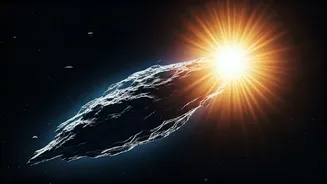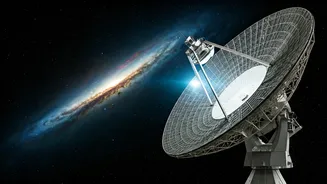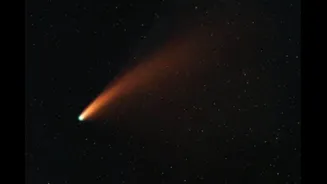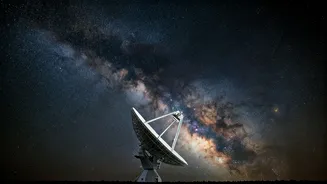Comet's Mysterious Journey
The emergence of interstellar comet 3I/ATLAS caused quite a stir among astronomers. This celestial body, which journeyed from beyond our solar system,
captured the attention of many due to its unusual behavior. Scientists were particularly intrigued by its unexpected survival after passing close to the sun. This event defied existing models and raised questions about the comet's composition and resilience. The comet's persistence, against all astronomical odds, fueled speculation about its nature, prompting diverse interpretations across the scientific community. Intriguingly, it wasn't just the comet's survival that made headlines; it also left a trail of radio signals. These signals acted like an echo throughout space. These events triggered renewed discussion about extraterrestrial possibilities, making the comet a focal point for researchers with an interest in the search for life beyond Earth. However, the exact reason for the comet's behavior continues to be debated. The origin and implications of the signals, along with the comet's survival, continue to be actively researched.
The Energy Puzzle
The unconventional behavior of comet 3I/ATLAS has presented scientists with some significant puzzles. The data collected didn't perfectly align with the existing theories of cometary behavior, and the comet's ability to survive such a close solar passage directly challenged existing models. The energy dynamics, particularly the comet's interaction with solar radiation, became an intense topic of analysis. The data suggested a level of resilience that scientists found difficult to explain. This discrepancy between theoretical predictions and observed reality drove researchers to re-evaluate their current comprehension of cometary structures and their responses to intense heat and radiation. The unusual energy patterns observed around the comet have prompted investigations. Scientists have been trying to determine if there were previously unknown processes involved. These observations challenge current understandings and encourage future analysis. The focus remains on deciphering these anomalies to gain a deeper comprehension of celestial object behavior. The challenge is to identify these processes that would reconcile the evidence. This research has led to important questions being posed about the nature of comets.
Alien Speculation Rising
The unusual characteristics of the comet, coupled with the detected radio signals, spurred a resurgence of interest in the possibility of alien life. This prompted a surge in hypotheses exploring the nature of the signal and its origin. The unique circumstances of the comet's survival, especially its defiance of the expected norms, gave further fuel to this belief. The speculation reached new levels when researchers analyzed the radio signals. There were multiple claims that the signals were artificial and, therefore, generated from an external source. Some theorized about how the object might have been engineered. Such bold assertions, although not universally accepted, have encouraged passionate debates among scientists and space enthusiasts. These ideas centered on the possibility of non-natural processes or even technologies. The nature of these signals, combined with the comet's improbable survival, opened a pathway for these kinds of speculative discussions. While the scientific community remains cautious, the comet has become an exciting subject for debate and investigation.
Skeptics Weigh In
While the interstellar comet fueled enthusiasm for the possibility of alien contact, many scientists expressed skepticism. They highlighted that extraordinary claims need extraordinary proof, urging prudence and rigorous methodologies. These skeptics focused on more probable explanations, often citing natural phenomena that could replicate the observed effects. One prevailing counter-narrative suggested that the comet's behavior was a rare but natural occurrence within the solar system, downplaying any need for alternative theories. It was suggested that the observed radio signals could be explained by known processes. The core of this perspective lies in the need for solid evidence. The sceptics argued against premature conclusions, encouraging a methodical approach that could identify all potential causes before making significant statements about alien involvement. This cautious viewpoint underscores the scientific process and reminds everyone to uphold high standards of evidence and thorough analysis.
What's Next for ATLAS?
The exploration of interstellar comet 3I/ATLAS is still continuing, with astronomers carefully examining the collected information and data. Ongoing investigations focus on several key areas, including additional studies of the comet's physical structure, trajectory, and chemical composition. Future research will need to involve new observations with sophisticated instruments, as well as a reassessment of existing data through updated models. This could reveal details about the comet's origins, which could provide better insights into its composition and how it may have evolved. Another priority is the radio signal, which will involve in-depth investigations into its structure, frequency, and pattern. These continued analyses may help resolve the debate about the comet's uniqueness and extraterrestrial possibilities. Regardless of the final interpretations, 3I/ATLAS has opened a path to some significant scientific questions and is certain to drive more research into comets. It will advance our understanding of how these celestial bodies behave. Ultimately, the future investigations on this comet will reveal insights into the broader search for life beyond Earth.














